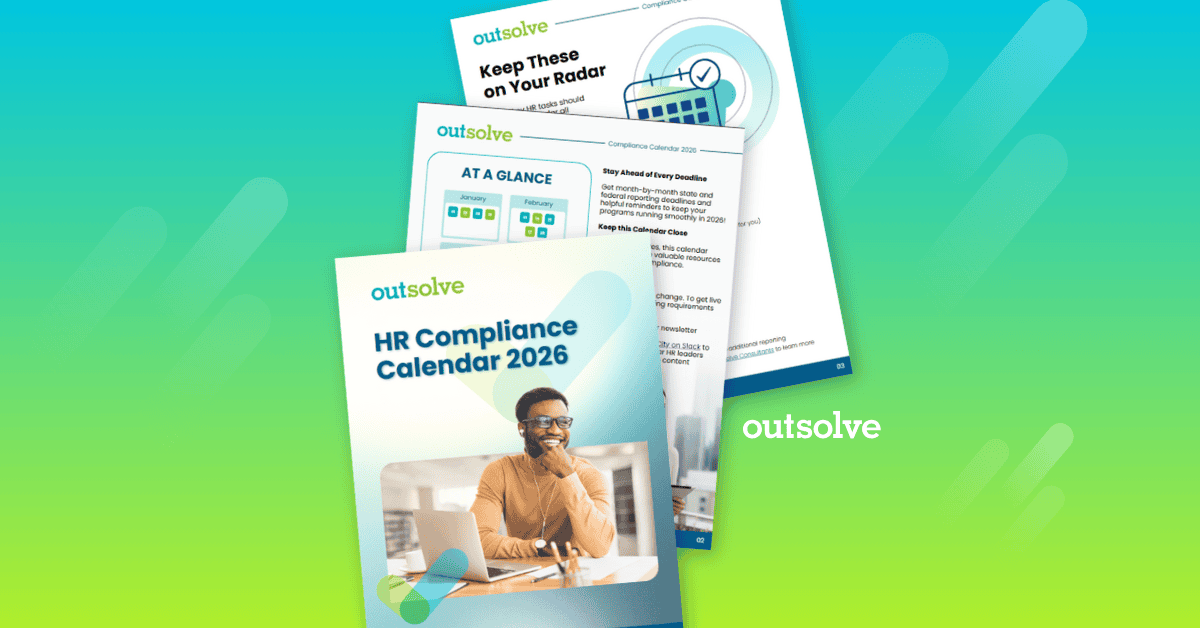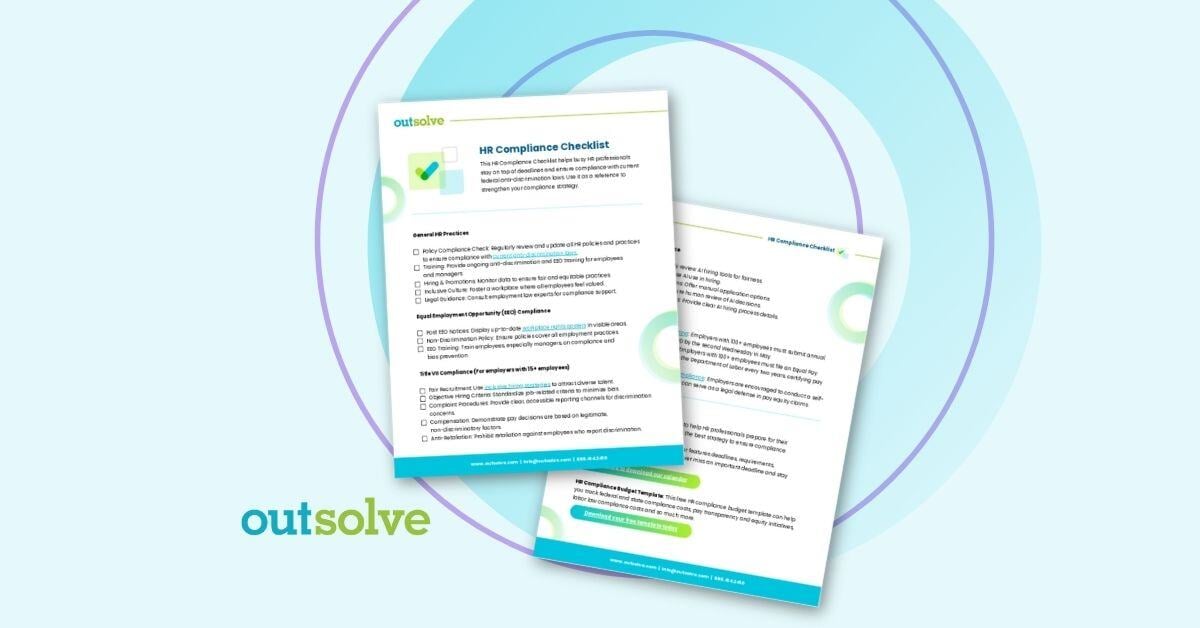4 min read
Preparing for an I-9 Inspection: A Proactive Employer’s Checklist
![]() OutSolve
:
Sep 18, 2025 4:39:33 PM
OutSolve
:
Sep 18, 2025 4:39:33 PM

This article is part of an ongoing legal series designed to provide insight and practical guidance on current and emerging workplace compliance issues. These insights shared by lawyers are based on their interpretation of existing regulations and proposed changes, and intended for informational purposes, not to be regarded as legal advice.
Under the Trump administration, immigration compliance and enforcement are priorities. Employers who hire noncitizens without work authorization are targets for enforcement, primarily through the I-9 inspection process. Being proactive starts with understanding how the I-9 inspection works, including how to interpret and respond to the results.
By understanding what can happen, you can tailor a plan to respond to and move forward from an I-9 inspection. Outsolve offers an I-9 employment verification solution and compliance assistance, including help with verification and documentation. Contact us to learn more.
Know the I-9 Inspection Process
Every employer must verify that workers they hire are authorized to work in the United States. Employers are required to use Form I-9, Employment Eligibility Verification. The government typically verifies that employers meet their obligations through I-9 audits. Audits begin with a Notice of Inspection (NOI), typically delivered by Immigration and Customs Enforcement (ICE) through certified mail.
What Triggers an I-9 Audit
What triggers an I-9 audit varies, often involving:
- Random selection,
- Reliable tips or complaints that the employer has violated their obligations, or
- Form I-9 errors that ICE discovers through other agencies or the verification process.
A history of past violations is one of the most common reasons for future audits.
Notice of Inspection
The NOI explains what information and documents you must provide, how to offer them, and where. Usually, ICE gives a minimum of three days to gather documents and deliver them to a location that ICE identifies in the NOI.
Inspection Results
ICE then reviews your materials to determine whether you are in compliance with the law. If they conclude that you are in compliance, they will issue a compliance letter, often titled “Notice of Inspection Results.” If the agency concludes that you or an employee may have violated the law, it issues a notice describing how and why.
Know the Possible Results
Potential I-9 inspection results could include:
- Identifying violations and imposing a fine;
- Allowing you or your employee time to correct issues; or
- Warning you that your business is out of compliance without issuing a fine.
If ICE finds any violations, they may schedule another inspection.
Correctable Notices
Some notices allow the employer or employee an opportunity to respond:
- Notice of Suspect Documents. An employee presented documents that may be fraudulent and don’t prove work authorization.
- Notice of Discrepancies. ICE cannot confirm whether an employee has work authorization.
- Notice of Technical or Procedural Failures. ICE has identified errors unrelated to hiring unauthorized employees, but related to incorrectly filling out Form I-9.
If the employer responds adequately to these requests, the I-9 inspection process may end.
Notices of Intent to Fine (NIF)
A NIF identifies:
- What violations ICE found, including what type of violation;
- How much ICE is fining the employer;
- What the employer must do to get into compliance; and
- Whether ICE is imposing any consequences beyond fines.
A NIF generally closes the I-9 inspection process, but the employer can appeal within 30 days.
Warning Notices
ICE may issue a Warning Notice instead of a NIF when an employer:
- Is out of compliance but cooperative and likely to become compliant in the future;
- Does not have a history of Form I-9 violations;
- Responds to the request to correct errors, if given;
- Completed and provided at least some Form I-9s;
- Did not hire unauthorized workers or at least did not knowingly and unreasonably hire unauthorized workers; and
- Does not appear to have fraudulently modified any I-9s, such as by backdating incomplete forms.
Warning Notices don’t result in fines, but ICE may schedule a follow-up inspection.
Know the Violations
Proactive employers can prepare for I-9 audits more effectively by learning what violates the law. ICE classifies I-9 violations as:
- Technical,
- Procedural,
- Substantive,
- Knowingly hire, and
- Continue to employ.
Some violations overlap slightly, and an employer can commit multiple violations simultaneously.
Technical Violations
Technical violations are typically simple data-entry mistakes. Examples include:
- Misspelled names,
- Birthdates with reversed date and month, or
- Typos in addresses.
If you don’t correct technical violations within ICE's ten-day window for corrections, they become substantive.
Procedural Violations
Procedural violations include errors you or your employees make related to the Form I-9 process. For example, an employer may commit a procedural violation by:
- Failing to complete Section 2 of the I-9 within three business days of the employee’s start date;;
- Accepting a document that is expired or not on the List of Acceptable Documents;; or
- Failing to complete an I-9 for one or more employees, despite completing most of the required I-9s.
Like technical violations, ICE usually gives an opportunity to correct procedural violations. If you don’t, they may become substantive violations.
Substantive Violations
Substantive violations go to the heart of I-9 requirements and typically involve employing unauthorized workers. The likelihood that ICE will impose fines for substantive violations depends primarily on:
- Whether the employer has committed and been found liable for past violations;
- Whether it’s reasonable under the circumstances that the employer might not have known an employee lacked authorization; and
- Whether the employer took corrective measures, especially whether they stopped employing unauthorized workers.
When an employer knowingly hires someone who lacks work authorization, the potential consequences become more severe.
Knowingly Hire Violations
An employer who knowingly hires unauthorized workers commits a particularly severe violation. Penalties are higher for violations where the employer knew the employee lacked authorization, and may increase significantly based on the situation.
Continue to Employ Violations
Finally, the most severe violations are typically continuing to employ. These violations involve employers who learn they have workers without authorization and continue to employ them. These violations often go hand in hand with knowingly hiring violations.
The consequences are most severe when an employer continues to employ unauthorized workers after going through the I-9 inspection process and being instructed to cease. ICE may pursue criminal liability against such employers and require them to forfeit large sums of money in severe cases, like an $80 million judgment from 2017.
I-9 Audit Checklist
Proactive employers can consult the I-9 audit checklist below to prepare a response plan for a possible I-9 audit.
- The I-9 Inspection process and timeline:
- The possibility of receiving an NOI and having to provide information and documents within three days.
- The possibility of getting a chance to correct issues.
- The right to appeal unfavorable results within 30 days.
- How to respond to each possible inspection result:
- Compliance Letter
- Notice of Suspect Documents
- Notice of Discrepancies
- Notice of Technical or Procedural Errors
- Notice of Intent to Fine
- Understanding and correcting violations, including:
- Technical
- Procedural
- Substantive
- Knowingly hire
- Continue to employ
Download OutSolve’s I-9 audit checklist for more suggestions on how to proactively audit your Form I-9s.
Get Proactive About I-9 Compliance
As I-9 enforcement increases, employers can prepare by understanding the process and building a response plan that anticipates potential issues and directs how to respond before, during, and after the I-9 inspection process.
Outsolve can help you get organized, verify employees, become compliant, and stay compliant. Contact us to learn more about our I-9 employment verification solution.
Founded in 1998, OutSolve has evolved into a premier compliance-driven HR advisory firm, leveraging deep expertise to simplify complex regulatory landscapes for businesses of all sizes. With a comprehensive suite of solutions encompassing HR compliance, workforce analytics, and risk mitigation consulting, OutSolve empowers organizations to navigate the intricate world of employment regulations with confidence.
Weekly OutLook
Featured Posts

New Year, New Deadlines: 2026 HR Compliance Calendar

outRageous HR: Plan Now or Pay Later
Related Posts

In-House or Outsourced I-9 Management: Which Is Best for Your Organization?
Every U.S. employer, regardless of size or industry, is required by law to confirm each new hire’s identity and verify that they are authorized to...

outRageous HR: Building a Compensation Strategy That Actually Works
If your compensation strategy is mostly “gut feeling” plus whatever you did last year… it’s time to rethink your approach.

HR Compliance Checklist: What Every HR Pro Needs to Know
During times of sweeping change to federal laws, and with new state laws being enacted, it's more important than ever for HR professionals to ensure...
